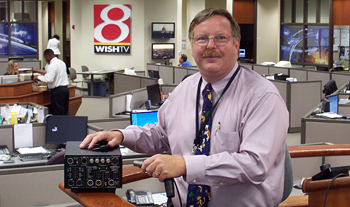Studio Technologies Sweetens Audio

Tom Weber
INDIANAPOLIS
We operate a multistation complex here, and are CBS and MyNetwork affiliates for the market. We have a very strong news operation and do quite a few remote broadcasts-sometimes two a day.
Audio has sometimes been referred to as the "poor stepchild" when it comes to television, but this has never been the case with us. In fact we are always on the lookout for new ways to make our audience's viewing-and listening-experience more rewarding.
Several new facilities such as the Lucas Oil Stadium, home of the Indianapolis Colts, have been built in our area, with numerous fiber runs to locations that can be up to 2,000 feet from point-to-point. Noting this, we began looking for a way to use this extensive fiber infrastructure for our remote broadcasts. Joseph Electronics, a broadcast distributor located near Chicago, told us about a remote camera interface system from Studio Technologies called Live-Link. We purchased two Live-Link systems a year ago and are quite pleased with our investment.
The Live-Link system consists of two units: a Camera End Unit that usually goes with the camera crew and a Control Room Unit that resides in a control room or truck. The system allows you to transport audio, video, intercom and data (between the two units) via a fiber optic connection.
For our needs, we're glad that Live-Link offers a lot more than just video transport over fiber. In addition to supporting analog and digital (HD and SD) video in both directions over two single-mode fibers, Live-Link uses these same two fibers to provide two channels of mic/line audio with switchable phantom power from the Camera End Unit, two line level signals from the Control Room Unit for IFBs, two channels of intercom, GPI/GPO connectivity for camera tallies, and data links for both RS-232/422 and Ethernet. Numerous status indicators make signal management intuitive.
For a high school football game, we get full use of Live-Link's audio and intercom capabilities by having the system connect the announcer mics to the audio console, IFB back to the announcers and also intercom for the camera operator. In addition, the system handles both an HD talent camera and a POV analog camera (scoreboard) feed from an announcer position. That's a lot of connectivity.
The Live-Link uses 12 VDC power and is supplied with an AC adapter with a standard four-pin connector. It also has an Anton/Bauer battery connector plate. We're able to get three to six hours of use on a fully charged battery brick, depending on use.
SOLID SYSTEM SUPPORT
The audio (and video) that we're bringing back with this system is nothing short of great. And the same can be said for the support that we've gotten from the folks at Studio Technologies. As with any new technology, there is a learning curve and the support department has been helpful in guiding us along. As one of the first users of the Live-Link system, the instruction manuals weren't ready when the equipment shipped, but Studio Technologies rose to the occasion by answering all of our questions, enabling us to put all of the system's capabilities to use.
Tom Weber is the engineering maintenance supervisor at WISH-TV and its sister stations. He has been in broadcasting for more than 30 years, and has overseen a wide range of building projects including remote trucks, transmitters, towers, studio facilities and a central casting hub. He may be contacted attom.weber@wishtv.com.
For additional information, contact Studio Technologies at 847-676-9177 or visitwww.studiotechnologies.com.
Get the TV Tech Newsletter
The professional video industry's #1 source for news, trends and product and tech information. Sign up below.
